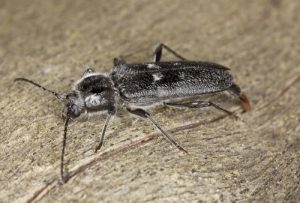Have an Old House Bore?
By Chris Williams on August 8, 2011.
Q. A pest control company told us we had old house bores feeding on the wood in our house! We found some holes in our basement beams. How serious are these bores?
A. Actually the old house bore is probably that geezer on the couch! I think you mean old house borers. These are fairly large beetles with fairly large larvae that tunnel and feed inside wood. Compared to powderpost beetles that also feed in wood, the old house borer leaves a large, oval exit hole (more than 1/4 inch diameter) when it emerges from the wood.
The adult beetle belongs to the “longhorned beetle” group, so called because of their long antennae. The old house borer is gray-brown with light gray hairs on its body, except for two shiny raised areas on its thorax, and is about one inch long. Adult beetles emerge from the exit holes in wood in July and August and may make their way to nearby windows or lights. It’s the beetle larvae, though, that do the feeding damage.
 Old house borer larvae are off-white, legless grubs that are about one inch long when fully grown. They tunnel through the wood as they feed, leaving behind powdery frass (feces). They have large mandibles that do the gnawing, leaving the side walls of the tunnels with a wavy, sculptured appearance. You can actually hear a rasping, clicking sound from the larvae chewing in the wood. If you hear that sound, it means you are dealing with larger larvae that have been feeding and growing for 3-4 years.
Old house borer larvae are off-white, legless grubs that are about one inch long when fully grown. They tunnel through the wood as they feed, leaving behind powdery frass (feces). They have large mandibles that do the gnawing, leaving the side walls of the tunnels with a wavy, sculptured appearance. You can actually hear a rasping, clicking sound from the larvae chewing in the wood. If you hear that sound, it means you are dealing with larger larvae that have been feeding and growing for 3-4 years.
The name old house borer is an unfortunate misnomer because this beetle is mainly a pest of new homes, those less than 10 years old. The infestation starts when the female beetle lays eggs in felled logs or in wood stored in a lumberyard. She chooses well-seasoned pine, fir, or spruce, but never hardwoods. The infested wood then gets used for framing lumber or joists in a structure. Infestations can occur anywhere in a building—in walls, attics, basements, or crawlspaces. The larvae feed for an average of 2 to 6 years inside the wood before pupating and emerging as adult beetles.
If you have a confirmed active infestation, meaning you have seen adult beetles or fresh exit holes, hear chewing sounds, or have noticed wood with a blistered or bulging surface, you should consider a professional treatment. You don’t say whether the pest control company did an inspection. Without a thorough inspection, you can’t know how extensive the infestation and damage is. Because old house borer larvae are large and feed for such a long time, they can do considerable damage. Most infestations remain localized and are limited to the one generation of emerging beetles, but if your basement has high enough moisture levels, the beetles can reinfest and continue to cause damage after the first generation.